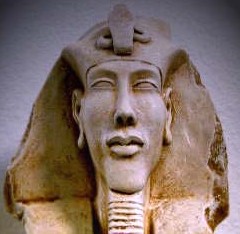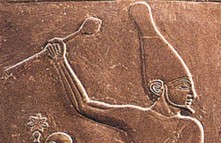

Cairo (972)
Philo of Alexandria (20bc-50ad)
Cleopatra VII Philopator (51-34 bc) was queen of Ptolemaic Egypt, the last
member of the Ptolemaic dynasty and hence the last Hellenistic ruler of Egypt
the Dendera light (1st century bc)
the Library of Alexandria (beginning of the 3rd century bc)
the Pharos of Alexandria (beginning of the 3rd century bc)
the Ptolemaic dynasty (305 - 30 bc)
Alexander the Great occupied Egypt (331 bc) and founded the city of Alexandria
the Thirtieth dynasty (380 - 343 bc)
the Twenty-ninth dynasty (398 - 380 bc)
the Twenty-eighth dynasty (404 - 398 bc)
the Twenty-sixth dynasty (672 - 525 bc)
the Late Period of Egypt (664 - 525 bc)
the Twenty-fifth dynasty (747 - 656 bc)
the Twenty-fourth dynasty (727 - 715 bc)
the Twenty-third dynasty (818 - 715 bc)
the Twenty-second dynasty (945 - 715 bc)
the Twenty-first dynasty (1069 - 945 bc)
the Third Intermediate Period ()
the Twentieth dynasty (1186 - 1069 bc)
Abu Simbel (1264 bc)
the Battle of Kadesh (1274 bc)
Ramesses II (1279-1213 bc)
the Nineteenth dynasty (1295 -1186 bc)
Tutankhamun (1333 - 1323 bc)

Akhenaten (1353 -1336 bc) concerned about abuses in the Osiris cult of Egypt, posited a new monotheistic religion,
perhaps the first, dedicated to the worship of the sun. And moved the capital of Egypt from Thebes to El-Amarna
the Colossi of Memnon (1370 bc)
the Exodus (around 1400 bc) was the departure of the
Hebrew slaves from Egypt under the leadership of Moses
Thutmose IV (1401-1391 bc) falling asleep beneath the giant head, dreamt that he was promised the crown if he would only
unbury the Sphinx. The young prince immediately formed an excavation party which, after much effort, managed to dig the front
paws out. To commemorate this effort, Tutmosis IV had a granite stela known as the Dream Stela placed between the paws
the Battle of Megiddo (1457 bc)
Hatshepsut (1503 - 1482 bc)
Moses (1526-1406 bc)
the Eighteenth dynasty (1550 - 1292 bc)
the Book of the Dead (16th century bc)
the Seventeenth dynasty (-1550)
the Hyksos invasion of Egypt (17th century bc)
the Second Intermediate Period ()
the Fourteenth dynasty (16??-)
the Thirteenth dynasty (1773-)
the Twelfth dynasty (1991-1802 bc)
the Egyptians domesticated the cat (2000 bc) for the purpose of catching snakes
the Middle Kingdom (2050) began with its capital at Thebes
the Eleventh dynasty (2125-1985 bc)
the Tenth dynasty (-2025)
the Ninth dynasty (2160-)
the Eighth dynasty (-2160)
the Seventh dynasty (2181-)
the First Intermediate Period ()
the Sixth dynasty (2345 - 2183 bc)
Ptahhotep (2400 bc) was vizier to Djedkare Isesi
the Fifth dynasty (2498 - 2345 bc)
Khafre's Pyramid (2532 bc)
Khafra (2558 - 2532 bc)
the Great Pyramid of Giza (2560 bc) was built as the tomb of pharaoh Khufu (Cheops),
after whom it is sometimes called Khufu's Pyramid or the Pyramid of Khufu
Djedefra (2566 - 2558 bc)
Khufu (2589 - 2566 bc)
the Great Sphinx of Giza (ca 2600 bc)
the Red Pyramid (ca 2600 bc)
Sneferu (2613 - 2589 bc)
the Fourth Dynasty (2613 - 2494 bc)
Huni ()
Khaba ()
Sekhemkhet ()
the Pyramid of Djzosèr (27th century bc)
Imhotep (2600 bc) as one of the officials of the Pharaoh
Djosèr he designed the Pyramid of Djzosèr
Djoser ()
the Third dynasty (2686 - 2613 bc)
the Old Kingdom (2686 - 2183 bc)
the 365 day calendar was introduced (2772 bc)
the Second dynasty (2890 - 2686 bc)

King Menes, also known as Narmer (3100 bc) unified the whole of the Nile Valley
between the Delta and the First Cataract at Aswan, with the centre of power in Memphis
the First dynasty (3100 - 2890 bc)
the Early Dynastic Period of Egypt (3100 - 2686 bc)
the Protodynastic Period of Egypt (3200 - 3100 bc)
hieroglyphs (3200 bc)
Egyptians introduced the world's first solar calendar (4236 bc)
Farming along the Nile (9500 bc) grain-grinding culture creates world's earliest stone sickle blades